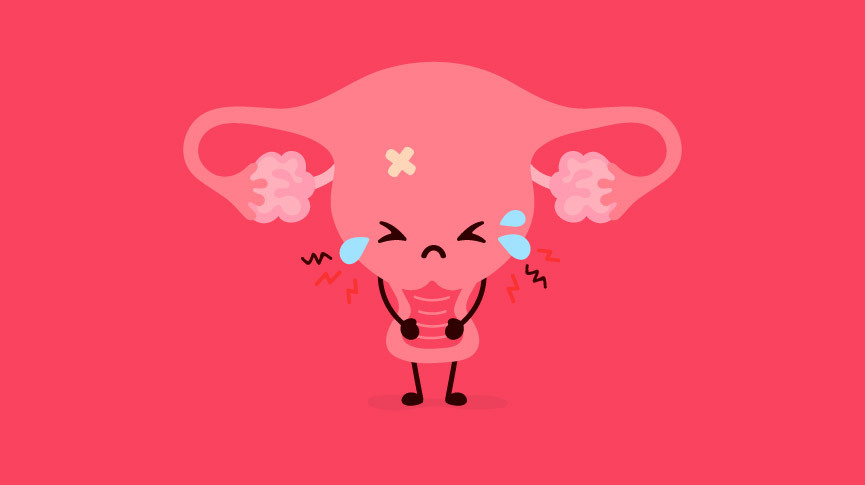What Exactly is a Friable Cervix?

If you’re not familiar with what your cervix is, often called your lady donut, you’ll be amazed by the wonders this little organ is capable of.
The cervix is the gateway from the vagina to the uterus. It helps clean and maintain your vaginal flora by secreting cervical fluid, keeps bacteria and pathogens away from your uterus, helps in conception by letting sperm through, letting period blood out, and when stimulated, can offer mind-blowing orgasms.
As with any other part of the body, things can go awry with it, like in the case of a friable cervix.
What is a Friable Cervix?
The world friable literally means easily crumbled. Not exactly a word you want describing your cervix. But that’s what happens when someone is experiencing this condition.
When the cervix is friable, the cervical tissue is more sensitive than usual, which can cause it to tear and bleed easily when touched.
Seeing as vaginas may see a lot of friction, you can see how this ailment can be an uncomfortable, oftentimes painful issue.
What are The Symptoms of a Friable Cervix?
Knowing what symptoms to look out for can help you determine whether or not you may have a friable cervix, and how to communicate that with your healthcare provider.
- Discomfort from penetration.
- Painful sexual intercourse, oftentimes called dyspareunia.
- Bleeding or spotting from intercourse.
- Abnormal vaginal discharge.
- Spotting in between periods.
- Vaginal itching, burning, and irritation.
It’s also possible to have no symptoms, and still be experiencing a friable cervix.
What Causes a Friable Cervix?
This uncomfortable condition is typically a symptom of an underlying condition.
Here’s a comprehensive, but not definitive list of what could be causing a friable cervix.
- Sexually Transmitted Infections: Certain STIs including chlamydia, gonorrhea, cervical herpes, trichomoniasis (parasite), can lead to inflammation or irritation of the cervix.
- Vaginal Atrophy: When the body has less estrogen, it can lead to the thinning, drying, and inflammation of the vagina.
- Menopause: When the body goes through menopause, hormonal changes can lead to vaginal and cervical imbalances.
- Hormonal Imbalances: A drop in estrogen from other factors include pregnancy, birth, lactation, undergoing a hysterectomy or removal of the reproductive organs.
- Medications: Some prescription medications, and cancer treatments.
- Cervical Ectropion: Sometimes known as cervical erosion.
- Cervical Polyps: Small elongated tumors that grow on the cervix, and are typically benign, aka not cancerous.
- Cervical Intraepithelial Neoplasia: An abnormal growth of cervical cells, typically caused by the Human Papillomavirus (HPV), and can become cancerous if left untreated.
- Hormone Replacement Therapy, as well as hormonal birth control.
- Hypothyroidism: A condition that causes the thyroid to be underactive.
- Coagulation Disorders: Conditions like hemophilia and Von Willebrand Disease that interfere with the body’s ability to control blood clotting.
- Cirrhosis of the liver.
- Intrauterine Devices, or IUDs.
- Pregnancy Complications.
- Vaginal Dysbiosis: An imbalance of unhealthy bacteria and yeasts versus good bacteria.
- Food Sensitivities: Many food sensitivities can cause inflammation, even in the cervix.
- Deregulated blood sugar and high insulin.
How Is a Friable Cervix Diagnosed?
The first thing a provider will probably do if a friable cervix is suspected is administer a pap smear, which collects cervical cells to test them for any abnormalities.
Next, your provider may perform a colposcopy. A procedure similar to a pap smear, that allows your provider to get a close-up examination of your cervix. During the procedure, they may take a sample for a biopsy, in order to rule out cancer.
Because many cases of the friable cervix are from an STI, your provider will most likely test you, and ask about your sexual history.
One of the next steps your provider will take is testing your hormone levels. Remember that a friable cervix is often caused by a hormonal imbalance.
How Do You Treat a Friable Cervix?
Because a friable cervix is usually a symptom of an underlying condition, treatment will depend on the root cause.
- Change Medications: Your provider may recommend changing any medications that can be causing a friable cervix.
- Antifungals: To treat any possible fungal infection.
- Antibiotics: Especially in the case of an STI, or other bacterial infection.
- Remove Polyps: If any are present.
- Hormone Replacement Therapy: If a friable cervix has developed around menopause, your provider may recommend HRT.
- Time: Especially in the case of pregnancy.
- Silver Nitrate: A salt compound used to cauterize blood vessels.
- Holistic Treatments: Providers like a naturopathic doctor will urge you to make dietary changes, as well as put you on a vitamin and mineral supplement protocol.
- Herbal Treatments: Prescribed by a licensed professional.
- Prevention: Prevent STIs by using condoms, and discussing your STI status with any new partners.
Oftentimes a friable cervix will clear up on its own without receiving further treatment.
Be sure to report any signs of a friable cervix to your provider, so that they can help get you and your cervix on the road to recovery!

Natasha (she/her) is a full-spectrum doula and health+wellness copywriter. Her work focuses on deconstructing the shame, stigma, and barriers people carry around birth, sex, health, and beyond, to help people navigate through their lives with more education and empowerment. You can connect with Natasha on IG @natasha.s.weiss.



Where is the super cute picture from? Who is the artist?